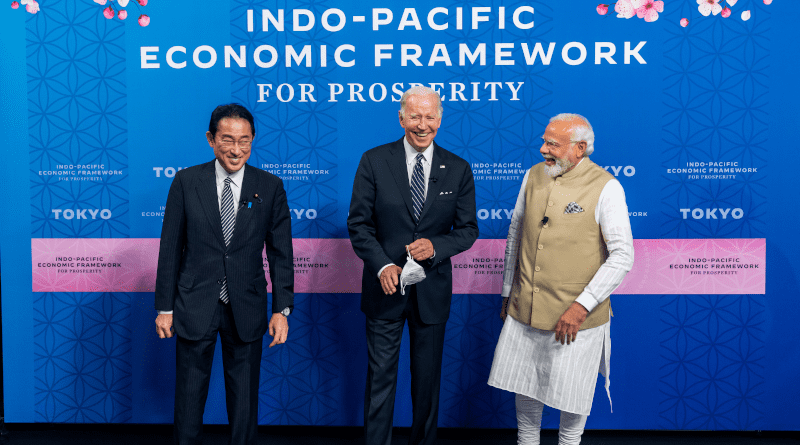IPEF: A New Challenge To Act East Policy, Albeit Under USA Leadership – Analysis
The launching of IPEF (Indo-Pacific Economic Framework) threw a new challenge to resurrect the Act East policy, which is facing bumpy roads after the withdrawal from RCEP (Regional Cooperation for Economic Partnership) in 2019. Of the 14 nation IPEF economic club, 9 are from South East Asia. They are South Korea, Singapore, Vietnam, Thailand, Indonesia, Malaysia, Philippines, Brunei, Fiji besides the USA, Australia, New Zealand, Japan and India. Together, they account for 40 percent of world trade and 60 percent of global population.
The main aim of the Act East Policy was to promote economic cooperation, cultural ties and develop strategic relations with countries in the Asia-Pacific region, thereby providing enough connectivity to the North East Region of India, according to official press notes. There is a fallacy that while the main aim of IPEF is to counterbalance China’s influences in Indo-Pacific region, 9 nations actually have FTAs (Free Trade Agreements) with China, either through RCEP or China-ASEAN FTA.
Over the last five years, the significance of Act East policy waned. Three factors attributed to this. First, was the rising Chinese influence, combined with growing China-India tensions. Second, India’s withdrawal from RCEP. Third, growing anti-minority policy, closely related to the Muslim religion.
A strong pro-India sentiment was generated among the South East Asian nations with India’s overwhelming success in overcoming the Asian financial crisis in 2008-2009. Further, India was recognized as a strong nation to defy China’s growing authority in the region. But, the pro-India sentiment faded with its withdrawal from RCEP.
Undoubtedly, IPEF is a brainchild of the USA to reinstate its influence in the Indo-Pacific region and a countermeasure to China’s growing geopolitical and geo-economic influence in the region. IPEF is an extension of the Quad — a security arrangement between USA, Japan, India and Australia — for reinforcing the USA’s Indo-Pacific strategy through economic measure, which have remained under China’s clout thus far.
Nevertheless, the irony is that while the strategic aim of IPEF is to resist China’s influence in the region, all the South Asian signatories to IPEF have FTAs with China. FTAs accelerates market access and foreign investment in the economic block. IPEF skipped any FTA. This raised eyebrows as how IPEF envisions success under the leadership of the USA to tame China’s influence, while China is the major trading partners of these nations. The absence of a FTA raised questions over the guaranteed market accessibility of these ASEAN nations. Rather, this might be an hindrance to the South East Asian nations, who depend on their export success to China. China is the biggest export destination for ASEAN.
IPEF will focus on three pillars – Connected economy, Resilient economy and Free economy. Connected economy will pursue for high standards for digital economy, such as cross-border data flows and data localization, increased opportunities for SMEs to reap benefits from E-Commerce; Resilient economy refers to seeking commitment for price stabilization for supply chain among the members and Free economy will seek commitment for fair taxation system, stringent regulations for anti–monetary laundering and anti-bribery arrangements.
There are four benefits which could stem from IPEF.
First, India’s entry into IPEF will accelerate the Act East policy. Progress of the Act East policy, which was hamstrung by China’s backdoor entry into India through ASEAN, will be re-energized. Since ASEAN signed a FTA with China in 2010, India witnessed a downfall in exports to ASEAN and an increase in imports from ASEAN. India entered a FTA with ASEAN in 2012. India’s exports declined by 4.4 percent during 2012-13 to 2019-20 and imports surged by 29.2 percent during the same period. It manifests that there was no other reason, but China’s backdoor entry to India through ASEAN-China FTA, which catalyzed the import surge from ASEAN.
Given the USA leadership to counter China and the 3 pillar norms under IPEF, China’s entry into India will likely be resisted under IPEF.
Second, with the launching of IPEF, India will emerge as a doyen to counter China in the region. This will pave the way for a re-emergence of pro-India sentiment in the region as India’s defiance against China will intensify, with the support of the USA and Japan.
Third, India is a digital power house. India is the second largest digitized economy among 17 leading economies, according to a McKinsey survey. India’s digitized power will help development of e-retailing, banking services, widening education facilities, delivery, factory inventory systems, and job creation in IPEF member nations. Countries like Thailand, Vietnam, Indonesia, Singapore, who are large trading partners of India in IPEF, will open opportunities for India’s service trade in digitization in these countries.
Fourth, India’s aspiration to be a global hub for supply chain will get a boost with the norm of a resilient supply chain , manifested in IPEF. There was a dramatic change in global supply chain trend in the post pandemic. The global supply chain has been re-worked, with a shift from low cost making nations to risk aversion sources. Eventually, India and Vietnam emerged as best options for alternatives to China. India, with power of digitization, is one step ahead of Vietnam to be considered as a hub for supply chain in Indo-Pacific region
In summing up, IPEF will allow to India to unearth new opportunities in Indo-Pacific region and reinforce its Act East policy. Since the USA is the biggest trading partner of India and the major foreign investor in it, the USA’s leadership in IPEF will leverage more opportunities in the region. Further, since the USA is not member of RCEP, the collaborative approach of the USA and India will pose a big challenge to Chinese influence in the region.

